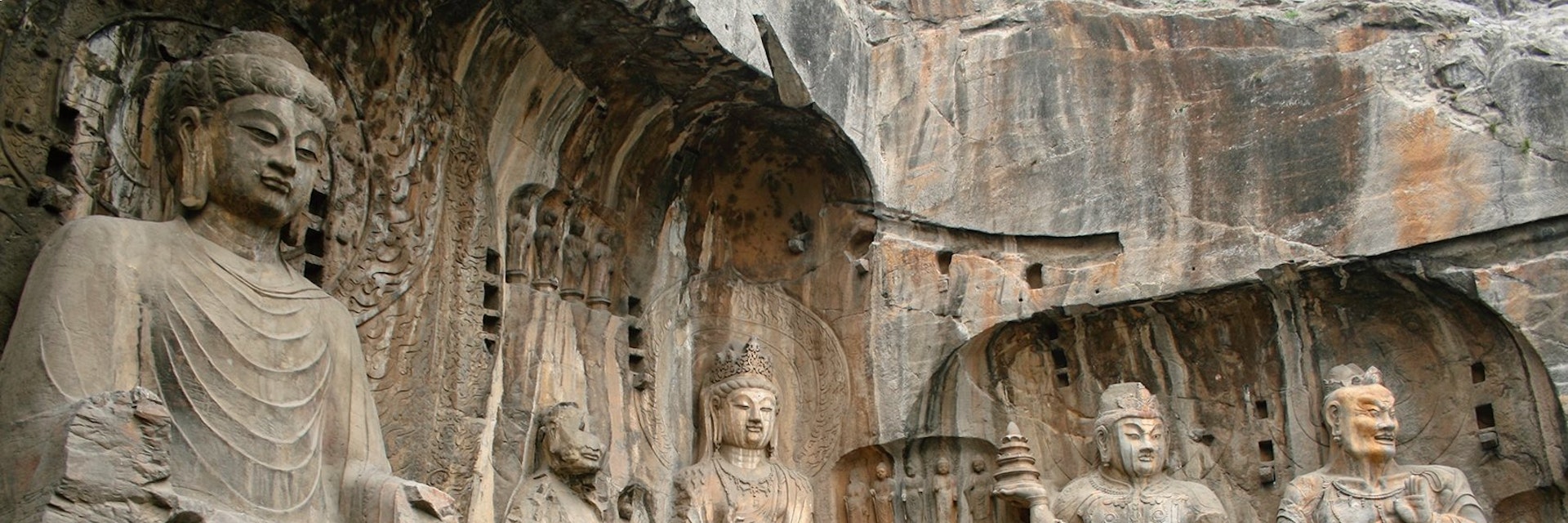The ravaged grottoes at Longmen constitute one of China’s handful of surviving masterpieces of Buddhist rock carving. A sutra in stone, the epic achievement of the Longmen Grottoes was commenced by chisellers from the Northern Wei dynasty after the capital relocated here from Datong in the year AD 494. Over the next two centuries, more than 100,000 images and statues of Buddha and his disciples emerged from over a kilometre of limestone cliff wall along the Yi River (伊河, Yī Hé).
The grottoes are scattered in a line on the west and east sides of the river. Most of the significant Buddhist carvings are on the west side, but a small crop can also be admired after traversing the bridge to the east side. Admission also includes entry to a temple and garden on the east side. English captions are rudimentary, although some carvings have English audio descriptions available via WeChat.
After you've seen the west side, you can take a boat (?25) back to the main entrance to get a riverside view of the grottoes (note that you can’t re-enter the west side once you leave). On the east side, electric carts (?10) can take you to a variety of locations. All in all, it's a 3km walk; expect to spend at least three hours here.
The grottoes are 13km south of Luoyang and can be reached by taxi (?30); bus 81 (?1.5, 50 minutes) from the west side of the long-distance bus station on Jinguyuan Lu (金谷园街); or bus 53 from Zhongzhou Donglu. A taxi from Longmen station will cost ?15. On the way back, be prepared to haggle or take the bus.
A disheartening amount of decapitation disfigures the statuary at this Unesco World Heritage Site. In the early 20th century, many effigies were beheaded by unscrupulous collectors or simply extracted whole, many ending up abroad in such institutions as the Metropolitan Museum of Art in New York, the Atkinson Museum in Kansas City and the Tokyo National Museum. Many statues have clearly just had their faces crudely bludgeoned off, vandalism that probably dates from the Cultural Revolution and earlier episodes of anti-Buddhist fervour. The elements have also intervened, wearing smooth the faces of many other statues.
West Side
Work began on the Three Binyang Grottoes (宾阳三洞, Bīnyáng Sān Dòng) during the Northern Wei dynasty. Despite the completion of two of the grottos during the Sui and Tang dynasties, statues here all display the benevolent expressions that characterised Northern Wei style. Traces of pigment remain within the three large grottoes and other small niches honeycomb the cliff walls. Nearby is the Moya Three Buddha Niche (摩崖三佛龛, Móyá Sānfó Kān), with seven figures that date from the Tang dynasty.
The Tang dynasty Ten Thousand Buddha Grotto (万佛洞, Wànfó Dòng) dates from 680. In addition to its namesake galaxy of tiny bas-relief Buddhas, there is a fine effigy of the Amitabha Buddha. Note the red pigment on the ceiling.
The most physically imposing and magnificent of all the Longmen carvings, the vast Losana Buddha Statue Grotto (奉先寺, Fèngxiān Sì) was created during the Tang dynasty between 672 and 675; it contains the best examples of sculpture, despite evident weathering and vandalism. Nine principal figures dominate: the Buddha, two disciples, two Bodhisattvas, two heavenly kings and two guardians. The 17m-high seated central Buddha is said to be Losana, whose face is allegedly modelled on Tang empress and Buddhist patron Wu Zetian, who funded its carving.
The Tang figures tend to be more three-dimensional than the Northern Wei figures, while their expressions and poses also seem more natural. In contrast to the otherworldly effigies of the Northern Wei, many Tang figures possess a more fearsome ferocity and muscularity, most noticeably in the huge guardian figure in the north wall.
East Side
Although the east side grottoes (东山石窟, Dōngshān Shíkū) lack comparable grandeur – many are even gated shut – there are still some gems to seek out here. The first stop you'll come across after crossing the bridge is the Leigutai Architectural Site (擂鼓台建筑遗址, Léigǔtái Jiànzhù Yízhǐ), which takes visitors through an earlier excavation, with various Tang and Song relics on display. It's through a pair of doors at the top of the steps.
Although badly faded, the delicate Thousand Arm and Thousand Eye Guanyin (千手千眼观音龛, Qiānshǒu Qiānyǎn Guānyīn Kān) in Grotto 2132 is a splendid bas-relief dating from the Tang dynasty, revealing the Goddess of Mercy framed in a huge fan of carved hands, each sporting an eye.
Further is the eastern side's largest site, the Reading Sutra Grotto (看经寺洞, Kàn Jīng Sìdòng), with a carved lotus on its ceiling and 29 expressive 濒耻ó丑à苍 (arhats) around the base of the walls.
At the top of a steep flight of steps, the Xiangshan Temple (香山寺, Xiāngshān Sì) nestles against a hill. It was first built in 516 and has been repeatedly restored. Look for the villa which once belonged to Chiang Kaishek, built in 1936 to celebrate his 50th birthday.
The final stop is a lovely garden built around the tomb of Bai Juyi (白居易墓地, Bái Jūyì Mùdì), a poet from the Tang dynasty. It’s a peaceful, leafy place with windy and secluded paths. Rest your tired feet at the shady alfresco cafe, where you can get tea (from ?98), snacks and instant noodles.



